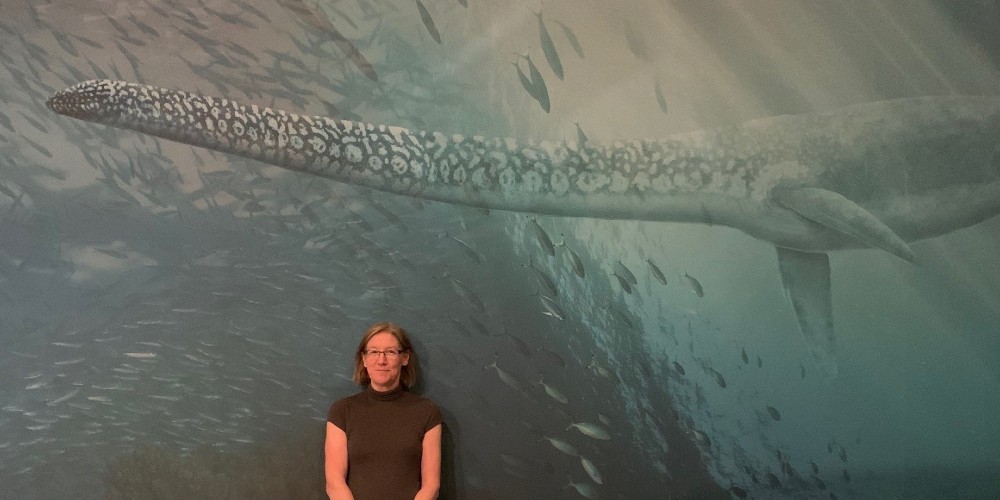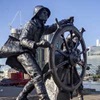![Sample wallpaper for Sea Monsters [Hawke Graphics] Sample wallpaper for Sea Monsters [Hawke Graphics]](/-/media/anmm/images/blog-content/2019/09-sep-2019/sample-wallpaper-from-sea-monsters_2160x1080.jpg?h=960&la=en&mw=1920&w=1920)
Sea Monsters takes you back hundreds of millions of years, to an underwater landscape where gigantic reptiles hunted the depths of the ocean. Combining real fossils, enormous replicas and hands-on interactives, you will learn how these monsters lived and how they compare to today's top ocean predators. While the objects serve as the main attraction, the graphics that accompany the exhibition help create this immersive underwater world.
Wanting to know more about the work that went into producing the vast array of images, we spoke to graphic designer Marianne Hawke, who has worked solely on Sea Monsters for the last five months.
How did you begin working as a graphic designer?
I went to art school and graduated with the classic concern of ‘what kind of job am I going to get after graduating from art school!?’ I was unemployed for a short time. Back then the Government had the Commonwealth Employment Program - they financed agencies to give the unemployed real experience.
That got me a job with the NSW National Parks and Wildlife Service. No one will remember this, but at that time everyone in Australia was changing over from Foolscap size paper to A4 [Foolscap is slightly taller and thinner than A4], and I had to redo all their brochures.

Marianne Hawke with an Elasmosaurus that features on one of the three-metre-high walls
So, I started with the basics –pasting headings and galleys of text (columns of text set out by typesetters were called ‘galleys’ but have nothing to do with ships). My wonderful bosses there kept adding to my job description, till it included display work. I wound up with a portfolio that miraculously got me a job at the Powerhouse Museum, just as the Powerhouse was being developed for the bicentenary.
I worked with a fantastic crew of exhibition and graphic designers at the Powerhouse, where I learnt just by watching and doing. I'd say this job was serendipity.
That experience led to jobs at the British Museum, the Museum of London and the Royal Armouries (at the Tower of London) during a stint in London. It was at this time designers started using computers!! – (those tiny Macintosh Classic II’s). We never looked back!
Several years later I took the leap of faith to go freelance in 2000, to create Hawke Graphics. Working mainly with exhibition designers Bannyan Wood, I designed graphics for many museums and state libraries around the country, and have had a great time doing so for almost 20 years.
After you were given the brief, how/where did you find your inspiration for Sea Monsters?
The brief was to create a sense of being underwater in a space sea monsters could have lived in. The team wanted the space to have that feeling of light coming down through water. We sourced images that had sense of rays of light, piercing areas of sea. Originally it was only going to be the sea, but when the curator sourced Gabriel's beautiful illustrations (of prehistoric ocean predators), we knew they had to be used at scale, merged into the ocean on the large wall graphics.
I started thinking about fossils and the seabeds they were embedded in – and how I might use that repeat graphic device across all the plinth tops to add a unity for changing thematic graphics to be based on. I (graphically) embedded ammonite fossils into the seabed. I thought it would be nice for the kids to find their own fossils as they walk around.
These environmental graphics serve as one of the exhibition’s bases. You don't want them to dominate because they are then overlaid with objects and inter-actives, and the many layers of information (text and images) that tell the story. You should be aware of them, but they shouldn’t dominate or detract from the stars – the objects.
One of the nicest things about doing work with museums is getting to see some of the objects that you are working with – it can send chills down your spine.
What type of graphics have you produced for Sea Monsters: Prehistoric Ocean Predators?
I designed all the environmental and interpretative graphics within the exhibition space. This includes all the wall graphics and plinth tops with all text and images including cartoons.
With museum graphics you’re doing everything – from tiny little pieces of text for an interactive to walls that are three-metres-high by 20-metres-long. So you work with lots of different levels of artwork and lots of different mediums. You also have to get your head around the 3D side of things.
It’s always a joy when all the different disciplines come together. But the big thrill is when the installers rig up all the lighting on the exhibition and the whole things springs to life as one huge underwater experience. So you’ve gone from a pile of design drawings to end up with this wonderful ‘living’ exhibition space.
![Sea Monsters exhibition graphics: plinth tops [Hawke Graphics]](/-/media/anmm/images/blog-content/2019/09-sep-2019/sea-monsters-exhibition-graphics-plinth-tops_1000.jpg?la=en)
![Sea Monsters exhibition graphics: plinth tops [Hawke Graphics]](/-/media/anmm/images/blog-content/2019/09-sep-2019/sea-monsters_exhibition-graphics_plinth-tops_1000.jpg?la=en)
Examples of the plinth tops that are featured throughout the exhibition. Image courtesy Hawke Graphics
What’s your creative process?
Well of course you start off studying the exhibition designer’s drawings of what they want the layout of the space to look like, and the curator’s vision of what story they want to tell. Using both as a guide, you start with sketching-up concepts. There are a lot of trial visuals and a lot of ideas you never end up using. But gradually the ideas start to gel. You start juxtaposing images, fonts and colours. For Sea Monsters I started with the brief for an immersive ocean and the colour palette, which flows from dark sea green, out to a lighter sea green, and then comes back through mid-blue to a darker blue.
Once you have a concept that’s working and is meeting everybody’s requirements – down to such things as, is the point size right, will a visitor be able to read the text? – you then start really fleshing out the design and getting down to the nitty gritty of it. You just have to patiently work through all the real problems of piecing together a huge job like this. There are thousands of measurements, many components that all have to fit together and you have to be across each and every one of these. It sometimes makes your head nearly explode!
Then there's the great joy of finishing all the final art (joking!). That’s creating the files for all the graphics that will go to the printer and that’s what you see in the exhibition. When I was doing that last part, at one point my (powerful!) computer refused to save a couple of the three-metre-high graphics and I had to go back to an earlier version and rebuild them. There was so much data the poor computer just freaked! That was a ‘whoa moment’ – time for a cup of coffee.
![Sea Monsters exhibition graphics: wallpaper sample [Hawke Graphics]](/-/media/anmm/images/blog-content/2019/09-sep-2019/plesiosaur-background---graphic-wallpaper_1000x613.jpg?la=en)
Sample of the three-metre-high wallpaper. Image courtesy Hawke Graphics
Part of the process is visualising then drawing up where all the components of the graphic need to go, how they interact together and how they can create a rhythm.
What did you find the most challenging about working on Sea Monsters?
Probably just the quantity of graphics needed – it was huge! With an exhibition of this scale, you might have a production house working on all the graphics, but it was just me.
What have you enjoyed the most about working on the exhibition?
Apart from working with all the people here, which is a lot of fun, I’ve learnt things. I learnt that there was a time where there was no oxygen in the ocean. I think they call it ‘anoxic’. It makes you sit up and go ‘oh okay, this has happened before on Earth and there’s no reason why it’s not going to happen again.’
I’ve also enjoyed seeing Gabriel’s drawings - I think they’re beautiful. It's always a joy when you get sent something to work with in an email and you go ‘oh, that’s truly lovely.’
![Sea Monsters exhibition graphics: wallpaper elevation [Hawke Graphics]](/-/media/anmm/images/blog-content/2019/09-sep-2019/wallpaper-elevation_1000.jpg?la=en)
Plan showing the wallpaper in relation to the objects and the showcases. Image courtesy Hawke Graphics
What's your favourite thing about your job?
Probably just playing with images on screen to create a new visual idea. Sometimes you look at it and go ‘that’s worked’ and that makes you feel good.
But otherwise it's nice doing the installations. It's such a solitary trade being a freelance graphic designer. It's very different when you come into the museum and you’re suddenly one of the team onsite, and you’re reminded of all the different people that put the whole thing together. It’s fun to come into the space and watch it all go up.
Want to learn more about Sea Monsters and the various creators we collaborated with to bring the exhibition to life? Be sure to visit our exhibition page where you can learn about paleoart and sculpting in VR. And if you haven't already, visit the exhibition so you can view Marianne's extensive work in-person and be transported to an underwater landscape.
